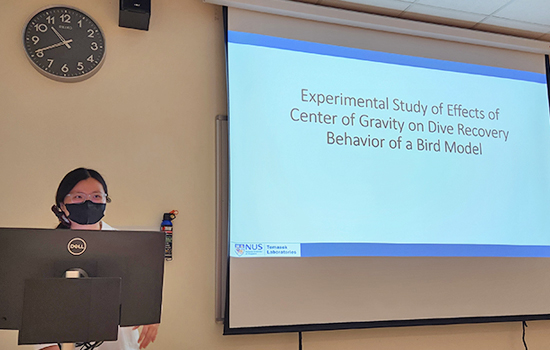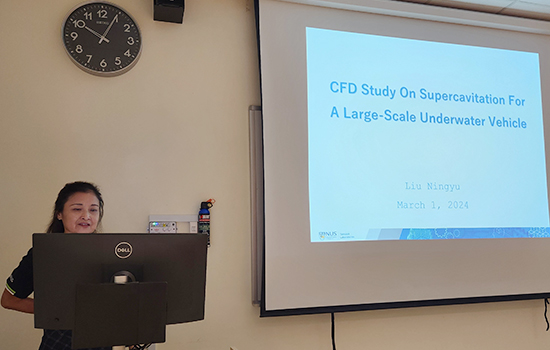Seminar
CFD Study on Supercavitation for a Real-Size Torpedo |
| 1 March 2024, Friday, 10:00 - 10:30am | Speaker: Dr. Liu Ningyu, Senior Research Scientist, TL@NUS |
| Venue: Seminar Room 8D-1, Level 8, Temasek Laboratories | Event Organiser Host: Dr. Huang Xin |
|
ABSTRACT |
Cavitation occurs when the pressure of a liquid drops below its vapor pressure, creating bubbles filled with vapor. Supercavitation utilizes these bubbles to decrease drag on objects like torpedoes, allowing them to move quickly. This study closely examines how cavitation affects torpedoes in numerical simulations, focusing on how reference pressure settings and torpedo speed impact cavitation shapes and drag coefficients. The simulations emphasize the importance of accurately setting the reference pressure and calculating the cavitation number to get reliable results, especially with real-sized torpedo models. As torpedo speed increases, the cavitation bubble expands and elongates. The simulations indicate that when the torpedo reaches a speed of approximately 98m/s in our current simulation model, the torpedo body becomes completely surrounded by cavitation, resulting in minimal drag. However, the results also indicate that while increasing torpedo speed can reduce drag, it may not do so efficiently enough. To improve performance, potential strategies include incorporating ventilation and jets, as well as optimizing the design of the cavitator and tail end. These approaches could effectively reduce drag and further enhance torpedo performance. |
| ABOUT THE SPEAKER |
|

Experimental Study of Effects of Center of Gravity on Dive Recovery Behavior of a Bird Model |
| 1 March 2024, Friday, 10:30 - 11:00am | Speaker: Ms. Chong Ren Ooi, Associate Scientist, TL@NUS |
| Venue: Seminar Room 8D-1, Level 8, Temasek Laboratories | Event Organiser Host: Dr. Huang Xin |

ABSTRACT |
When birds dive to catch their prey, they tuck their wings close to the body, and spread their wings out towards the end of their dive, allowing them to recover. A simple fixed wing model, with its wing shape modeled using a seagull’s wings, was used for this study. As the model is dropped from a height, its trajectory was recorded to study the dive recovery behavior. The drop test was done for 3 different center of gravity to study how a change in the center of gravity of the model affects its dive recovery behavior. |
| ABOUT THE SPEAKER |
|




 Dr. Liu Ningyu holds a Bachelor's degree in Aerodynamics from Nanjing University of Aeronautics and Astronautics. In 1984, she began her career as an Engineer at Chengdu Aircraft Manufacturing Corporation. Later, she earned her Master's degree in Computational Fluid Dynamics (CFD) from the National University of Defense Technology of China and worked as a lecturer at Hefei University of Technology. In 1998, she completed her Ph.D. in CFD from the University of Science and Technology of China. Since then, Dr. Liu has been actively engaged in research, serving as a Research Fellow at Nanyang Technological University (NTU), the National University of Singapore (NUS), and as a Scientist at DSI within A-star. In 2017, she transitioned to Temasek Laboratories, where she continues her research endeavors. Dr. Liu's expertise lies in CFD, with a focus on various areas including particle trajectory simulation, multiphase flow, flow-structure interaction, micro-flow, and nano-flow.
Dr. Liu Ningyu holds a Bachelor's degree in Aerodynamics from Nanjing University of Aeronautics and Astronautics. In 1984, she began her career as an Engineer at Chengdu Aircraft Manufacturing Corporation. Later, she earned her Master's degree in Computational Fluid Dynamics (CFD) from the National University of Defense Technology of China and worked as a lecturer at Hefei University of Technology. In 1998, she completed her Ph.D. in CFD from the University of Science and Technology of China. Since then, Dr. Liu has been actively engaged in research, serving as a Research Fellow at Nanyang Technological University (NTU), the National University of Singapore (NUS), and as a Scientist at DSI within A-star. In 2017, she transitioned to Temasek Laboratories, where she continues her research endeavors. Dr. Liu's expertise lies in CFD, with a focus on various areas including particle trajectory simulation, multiphase flow, flow-structure interaction, micro-flow, and nano-flow. Chong Ren Ooi obtained her Bachelor of Engineering in Mechanical Engineering from NUS in 2020. She joined Temasek Laboratories in 2021 as an associate scientist.
Chong Ren Ooi obtained her Bachelor of Engineering in Mechanical Engineering from NUS in 2020. She joined Temasek Laboratories in 2021 as an associate scientist.